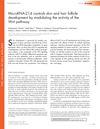Faculty Opinions Recommendation of Wnt-Dependent De Novo Hair Follicle Regeneration in Adult Mouse Skin After Wounding

TLDR Hair can regrow in adult mice's skin after injury, and this process can be boosted by increasing Wnt7a, a protein. This could potentially help treat baldness and change our understanding of hair growth.
This study from 2007 reveals that hair follicles can be generated de novo during wound healing in adult mice. The researchers found that the hair follicles formed at the center of larger wounds are derived from keratinocytes of the epidermis, rather than from pre-existing follicular stem cells. The study also showed that overexpression of Wnt7a in the epidermis expanded the zone of follicle formation, suggesting a critical role for Wnt signaling in the regeneration of follicles. This research suggests a potential mechanism for treating baldness by topically applying agents to promote hair growth. It challenges the long-held belief that humans are born with their full complement of hair follicles and that postnatal and pubertal hair growth occurs only through enlargement of existing follicles. This study is particularly relevant for patients with scarring alopecia, as it proposes a paradigm shift in our understanding of wound healing and hair growth.





